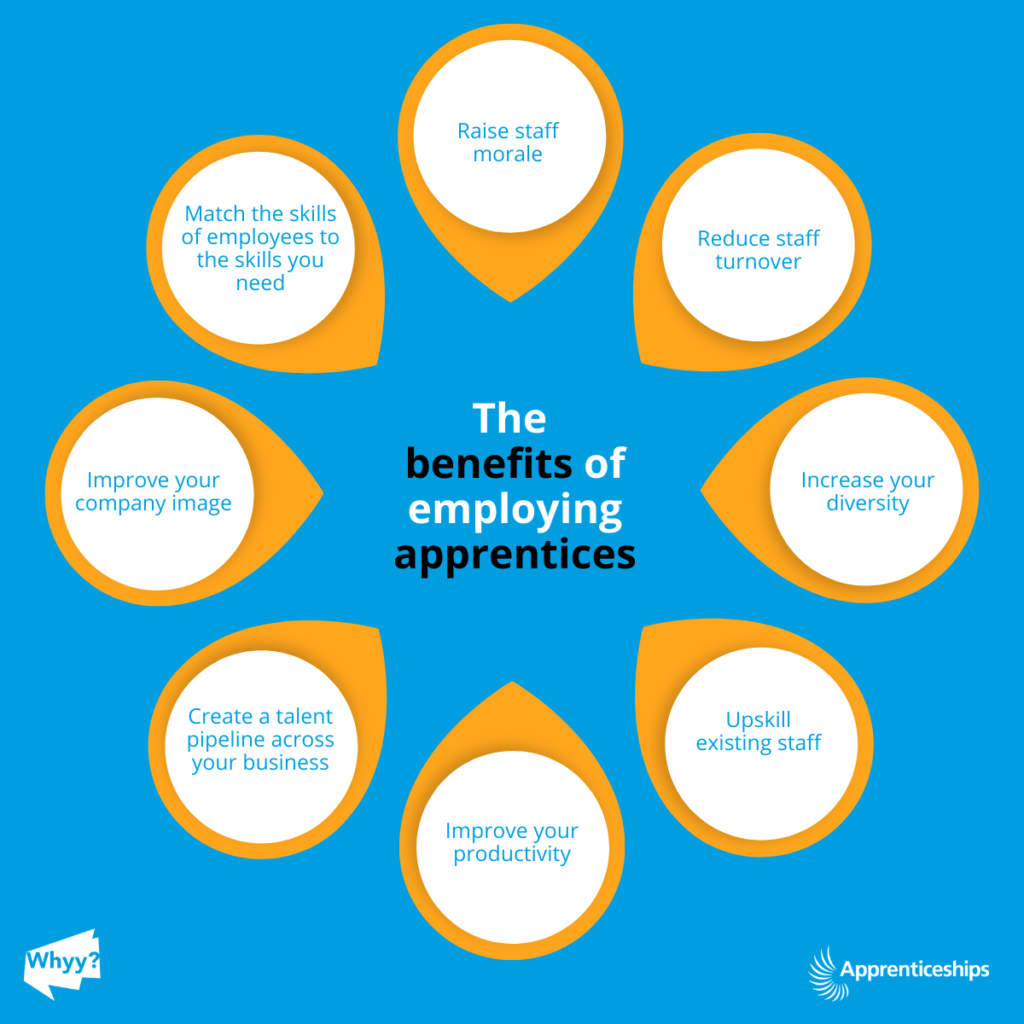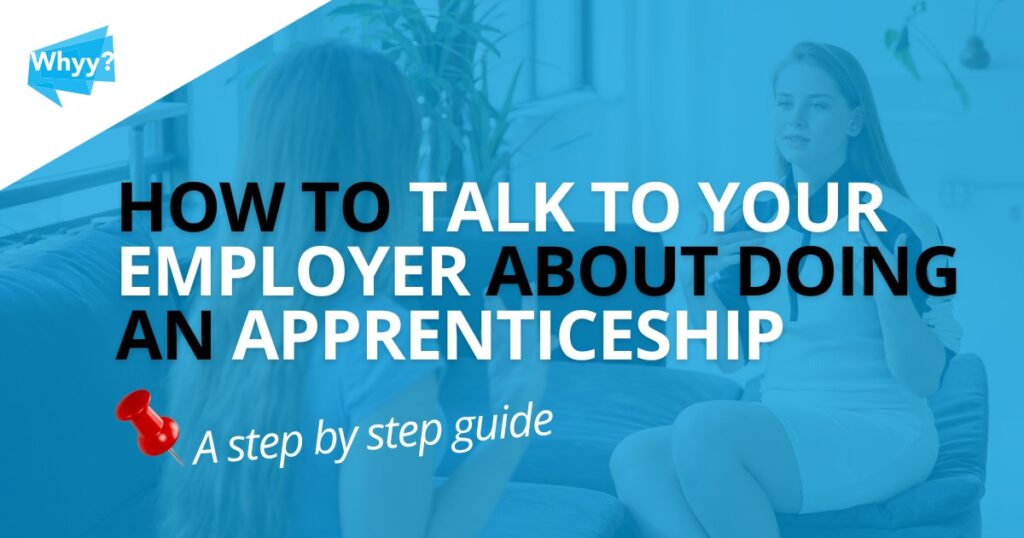Starting an apprenticeship is a commendable step towards upskilling, career progression, and long-term success. However, discussing this ambition with your employer requires thoughtful planning, timing, and communication. This step-by-step guide will help you get ready, present your proposal, and confidently ask your employer about doing an apprenticeship.
Understanding the Value of Apprenticeships
Apprenticeships blend practical training with academic learning, offering employees the opportunity to develop new competencies while continuing to work and earn. Employers benefit by gaining skilled, loyal talent that aligns with their business objectives. There are many benefits that apprenticeships offer employers, here are just a few…
Key benefits of apprenticeships:
- Government funding available: If you work for a smaller business, the government will cover 95% of apprentice training costs. For businesses with a £3 million payroll, the apprenticeship levy can fund training.
- Role-specific, flexible learning: Tailored to your job and career path.
- Increased employee retention and engagement: Improves morale and loyalty.
- Aligned with national standards: Meets professional qualifications.

When Is the Right Time to Approach Your Employer?
Timing is crucial. Plan to raise the conversation when your manager is most receptive, ideally during:
- Annual performance reviews
- One-to-one meetings
- Professional development planning sessions
- Organisational training budget reviews
Avoid peak busy periods, product launches, or internal restructures.
Step-by-Step Guide: How to Talk to Your Employer About Doing an Apprenticeship
1. Do Your Homework First
Before initiating the conversation:
- Identify the right apprenticeship: Match your current role or desired career path with a government-recognised apprenticeship standard. Understand the full scope of the apprenticeship programme, e.g. qualification level, subject area, schedule, and delivery method.
- Choose an approved training provider: Ensure the provider is registered with the ESFA (Education and Skills Funding Agency) and check their Google Reviews for credibility.
- Understand the commitment: Know the time, duration, and on-the-job training required (minimum 20% off-the-job learning).
2. Align the Apprenticeship with Business Goals
Demonstrate how the apprenticeship will make you better at your job, and how that will support your team’s objectives, to deliver value:
- Increase productivity in your department
- Reduce outsourcing costs by upskilling internally
- Strengthen capabilities that align with growth strategies
- Support digital transformation or operational efficiency
💡 Tip: Use measurable outcomes and benchmarks where possible.
3. Prepare a Proposal Document
Include:
- The apprenticeship standard and title
- Provider information and reputation
- Duration, structure, and time commitment
- Cost breakdown and available funding
- How it benefits the business and your team
- Timeline and next steps
💡 Tip: Tailor the proposal to your organisation’s goals and tone of voice. Avoid generic language.
Structuring a Professional Conversation
Use this framework to guide your discussion:
- Express Commitment
Reiterate your dedication to your role and the business. - Present the Proposal
Explain what the apprenticeship is, how it works, and why you’re interested. - Align with Business Goals
Show how your upskilling will lead to direct outcomes, improved productivity, cost savings, or increased team capacity. - Address Concerns Proactively
Be prepared with answers for any logistical or cost-related objections. - Suggest Next Steps
Offer to provide documentation, speak with HR, or follow up with more details.
How to Frame the Conversation with Your Manager
Use confident, positive, and business-oriented language. Here’s one way you might ask your employer for an apprenticeship:
“I’ve been exploring ways to enhance my skills in [specific area], and I’ve identified an apprenticeship in [programme title] that’s directly relevant to our goals in [project/team/department]. It’s government-funded, and the training provider is Ofsted-rated ‘Good’. I’d love to discuss how this could contribute to our team’s performance.”
Avoid framing it as a personal favour or purely for your own benefit; don’t forget this is a business development opportunity.
Addressing Common Employer Concerns
| Concern | How to address it |
| “We don’t have the budget.” | “Many apprenticeships are 95–100% government-funded through the Apprenticeship Levy or co-investment schemes.” |
| “We can’t afford the time away.” | “Only 20% of the time is spent in off-the-job training. It keeps me growing, motivated and bringing knowledge back into the business” |
| “We’re unsure it fits your role.” | “The programme aligns directly with my responsibilities and supports our team’s strategic objectives.” |
| “What’s the ROI?” | “You’d gain a more skilled, committed team member at a fraction of the cost of external hiring or training, while contributing to long-term workforce resilience.” |
How to answer “why do you want an apprenticeship?”
To answer the “why do you want an apprenticeship” question, you could say something like:
“I’d like to do an apprenticeship because it directly aligns with my long-term career goals. This opportunity will equip me with practical, hands-on skills that are essential for advancing in my role. By gaining experience in [specific area, e.g., project management, leadership], I’ll be better positioned to contribute more effectively to the team, support business growth, and ultimately take on more strategic responsibilities in the future.”
Funding Options Your Employer Should Know
Many employers are unaware of how accessible apprenticeship funding can be.
Available Options:
- Apprenticeship Levy: Large employers can use existing contributions to fund training.
- SME Co-Investment: Smaller businesses pay just 5% of costs.
- National Insurance Costs: Hiring apprentices under 25 can eliminate the employer NIC contribution
- Government Grants: Employers hiring apprentices aged 16-18, or those aged 19-24 with an Education, Health, and Care Plan (EHCP) or who have been in care, may receive a £1,000 grant to offset workplace costs.
The impact apprenticeships can have ⬇️
Employer Success Story – Sonoco plc, Packaging Solutions Manufacturer
Sonoco invested in apprenticeships to upskill their managers, process engineers and quality practitioners via the apprenticeship levy across their sites at Chesterfield, Bradford and Stainland in the UK.
Employer Success Story – Horizon Platforms, Plant and Machinery Rental Company
Horizon Platforms set out to strengthen their marketing efforts, they didn’t hire an agency or expand their team. They invested in marketing internally, enrolling an existing team member on a Marketing Apprenticeship. The result? A 15% increase in revenue.
Discover more success stories.
What to Do If They Say No
Not every employer is immediately receptive. If your request is declined:
- Ask for detailed feedback
- Revisit the timing and business case
- Explore internal development opportunities as a stepping stone
- Keep a record and revisit the conversation during the next performance review
Persistence, professionalism, and preparation are key.
Make a Business Case, Not Just a Request
Approaching your employer about an apprenticeship requires preparation, professionalism, and clarity. With the right groundwork, you can position yourself as a proactive asset to your organisation and secure their support in your development journey.
Final Checklist: Are You Ready?
✅ Clear understanding of your apprenticeship goals
✅ A strong business case
✅ Awareness of funding routes
✅ Knowledge of the apprenticeship structure
✅ Confidence to present your proposal
Make your next move with Whyy? Change
Ready to take the next step in your career with an apprenticeship? Whyy? Change offers expert guidance to help you build a compelling case for your employer, from choosing the right programme to unlocking funding and preparing a professional proposal.
Chat with the team today and turn your career goals into a strategic plan your employer will support. To get started, simply fill out the form below!

